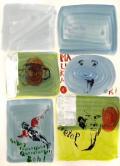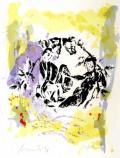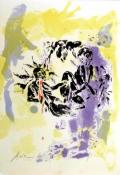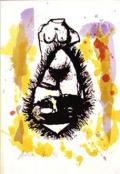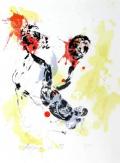enquiries@muka.co.nz
ADAMSKI, Hans Peter
Nationality: Germany
Website: Website
German artist
Born in Kioster, Oesede 1947
Lives and works in Berlin
Images are travellers, transient, never perfect. Art should never be perfect. Perfection implies conclusion, an end. And why should this be the end? Why can’t we go any further?
To attempt to answer these is to embark on a vicious circle; the end is the beginning and the beginning is the end of this.
Hans Peter Adamski has spent the last 25 years of his creative endeavour experimenting, continually looking for open-ended questions. In the seventies he built up a reputation as a conceptual artist. At that time German art had been intellectualized into a dead-end. Young artists influenced by the Dusseldorf Academy - under the directorship of Joseph Beuys - found themselves bound to the strict confines of conceptual art and Beuys’s philosophy that anyone could produce art.
Adamski joined forces with Peter Bömmels, Georg Jiri Dokoupil, Walter Dahn, Gerd Kever and Gerhard Naschberger: together they became the legendary “Mulheimer Freiheit”, and an internationally renowned group of the so-called “Young Wild Movement” discovered and promoted a few years earlier by Cologne gallery owner Paul Maenz.
The Mulheim artists rejected contemporary thinking, preferring to paint instinctually, liberating heart and mind. As conceptual base they had the motto: “Anything goes”. This included any kind of material and any form of spiritual or intellectual expression. They re-entered the metaphorical playground, suppressing the calculating rational mind in order to let the soul play freely. This resulted in the reappearance of the oldest and most honest kind of painterly narrative; corporality expressed in images of the body itself. They painted figures vomiting, shitting, dancing, singing, wildly copulating, even painting.....
They united the banal and the sublime and created a world seemingly totally deprived of conventional meaning; a creative, honest, intelligent, raw and unashamed existence. It was and remains an unequalled creative endeavour, almost violent in its vigour. The Mulheim group laid the cornerstone for artistic freedom while playfully bringing this freedom to absolute expression, challenging the generations to follow.
Within this framework, H.P. Adamski developed his own artistic philosophy. He searched for meaninglessness and meaning, monotony without boredom, sympathy and apathy, and he discovered the charm of bad art, the comic appeal and attractive awkwardness of hobby art. He became fascinated by the decorative and started to blend the tragic-comic elements of hobby art with the tonal statements of architectural ornament.
He drew on these to prepare letter types for his embroideries and for a new series of panel paintings. The new images combined pamphlets and word play to form a bridge to conceptual art. The austerity of the embroidered shapes and ornaments was countered by wire wall sculptures - not unlike found objects - and by content-laden images combining several themes.
M.A.
Born in Kioster, Oesede 1947
Lives and works in Berlin
Images are travellers, transient, never perfect. Art should never be perfect. Perfection implies conclusion, an end. And why should this be the end? Why can’t we go any further?
To attempt to answer these is to embark on a vicious circle; the end is the beginning and the beginning is the end of this.
Hans Peter Adamski has spent the last 25 years of his creative endeavour experimenting, continually looking for open-ended questions. In the seventies he built up a reputation as a conceptual artist. At that time German art had been intellectualized into a dead-end. Young artists influenced by the Dusseldorf Academy - under the directorship of Joseph Beuys - found themselves bound to the strict confines of conceptual art and Beuys’s philosophy that anyone could produce art.
Adamski joined forces with Peter Bömmels, Georg Jiri Dokoupil, Walter Dahn, Gerd Kever and Gerhard Naschberger: together they became the legendary “Mulheimer Freiheit”, and an internationally renowned group of the so-called “Young Wild Movement” discovered and promoted a few years earlier by Cologne gallery owner Paul Maenz.
The Mulheim artists rejected contemporary thinking, preferring to paint instinctually, liberating heart and mind. As conceptual base they had the motto: “Anything goes”. This included any kind of material and any form of spiritual or intellectual expression. They re-entered the metaphorical playground, suppressing the calculating rational mind in order to let the soul play freely. This resulted in the reappearance of the oldest and most honest kind of painterly narrative; corporality expressed in images of the body itself. They painted figures vomiting, shitting, dancing, singing, wildly copulating, even painting.....
They united the banal and the sublime and created a world seemingly totally deprived of conventional meaning; a creative, honest, intelligent, raw and unashamed existence. It was and remains an unequalled creative endeavour, almost violent in its vigour. The Mulheim group laid the cornerstone for artistic freedom while playfully bringing this freedom to absolute expression, challenging the generations to follow.
Within this framework, H.P. Adamski developed his own artistic philosophy. He searched for meaninglessness and meaning, monotony without boredom, sympathy and apathy, and he discovered the charm of bad art, the comic appeal and attractive awkwardness of hobby art. He became fascinated by the decorative and started to blend the tragic-comic elements of hobby art with the tonal statements of architectural ornament.
He drew on these to prepare letter types for his embroideries and for a new series of panel paintings. The new images combined pamphlets and word play to form a bridge to conceptual art. The austerity of the embroidered shapes and ornaments was countered by wire wall sculptures - not unlike found objects - and by content-laden images combining several themes.
M.A.

